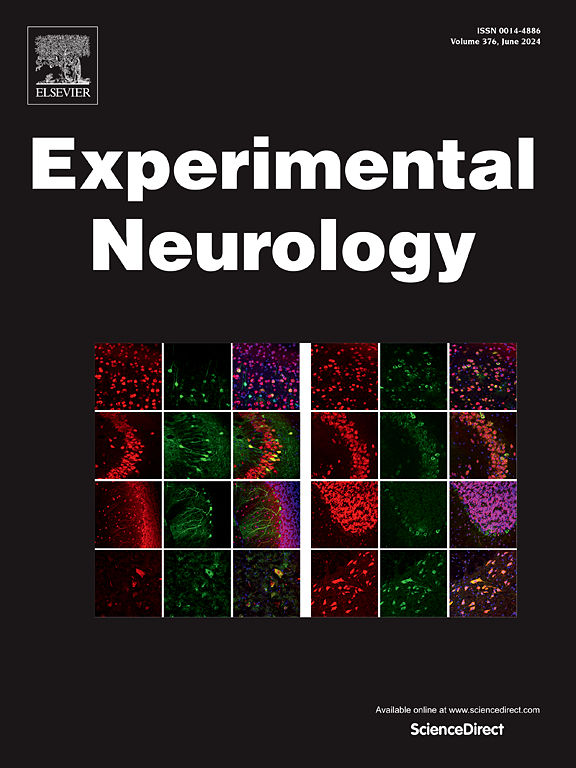Head-down tilt 15° increases cerebral perfusion before recanalization in acute ischemic stroke. A pre-clinical MRI study
IF 4.2
2区 医学
Q1 NEUROSCIENCES
引用次数: 0
Abstract
We investigated the therapeutic effect of head-down tilt at −15° (HDT15) on cerebral collateral flow and early infarct growth in a rat model of large vessel occlusion stroke, using multi-modal MRI. Endovascular occlusion of the proximal middle cerebral artery was induced for 90 min in Wistar rats (n = 28), followed by reperfusion. Rats were randomly assigned to HDT15 or flat position for 60 min, starting 30 min after occlusion. Multi-modal brain MRI, including perfusion, angiographic and structural sequences were acquired before treatment, after 60 min of treatment and 24 h after reperfusion. The primary outcome was change in cerebral perfusion after the 60-min treatment, assessed by time-to-peak (rTTP), adjusted for baseline collateral score. The secondary outcome was infarct growth in the first 24 h. The perfusion shift analysis, comparing post- versus pre-treatment changes in time-to-peak maps, showed a significant increase in cerebral perfusion in the HDT15 group (common odds ratio 1.50; 95 % CI 1.41–1.60; p < 0.0001), but not in the flat group (common odds ratio 0.97; 95 % CI 0.92–1.03; p = 0.3503). Early infarct growth at 24 h was +15.4 % in the HDT15 group (224 versus 192 mm3; 95 % CI -26.9 to 85.9; p = 0.2272) and + 31.4 % in the flat group (343 versus 250 mm3; 95 % CI 2.4 to 165.1; p = 0.0447). In conclusion, MRI-based analysis indicated that HDT15 acutely increased cerebral perfusion in large vessel occlusion and exerted a tissue-saving effect before recanalization in experimental ischemic stroke.

头部向下倾斜15°可增加急性缺血性脑卒中再通前的脑灌注。临床前MRI研究
我们利用多模态MRI研究了头向下倾斜- 15°(HDT15)对大鼠大血管闭塞性卒中模型脑侧支血流和早期梗死生长的治疗作用。Wistar大鼠(n = 28)脑中近端动脉血管内闭塞90 min后再灌注。大鼠被随机分配到HDT15或平位60分钟,从闭塞后30分钟开始。分别于治疗前、治疗后60 min和再灌注后24 h进行多模态脑MRI,包括灌注、血管造影和结构序列。主要终点是治疗60分钟后脑灌注的变化,通过峰值时间(rTTP)评估,并根据基线侧支评分进行调整。次要结局是头24小时内的梗死生长。灌注移位分析,比较治疗后与治疗前的时间峰图变化,显示HDT15组脑灌注显著增加(常见优势比为1.50;95% ci 1.41-1.60;p & lt;0.0001),但平坦组没有(常见优势比0.97;95% ci 0.92-1.03;p = 0.3503)。HDT15组24小时早期梗死面积增加15.4%(224对192 mm3;95% CI -26.9至85.9;P = 0.2272)和+ 31.4% (343 vs 250 mm3;95% CI 2.4 ~ 165.1;p = 0.0447)。综上所述,基于mri的分析表明,HDT15在实验性缺血性脑卒中大血管闭塞时急性增加脑灌注,并在再通前发挥组织保存作用。
本文章由计算机程序翻译,如有差异,请以英文原文为准。
求助全文
约1分钟内获得全文
求助全文
来源期刊

Experimental Neurology
医学-神经科学
CiteScore
10.10
自引率
3.80%
发文量
258
审稿时长
42 days
期刊介绍:
Experimental Neurology, a Journal of Neuroscience Research, publishes original research in neuroscience with a particular emphasis on novel findings in neural development, regeneration, plasticity and transplantation. The journal has focused on research concerning basic mechanisms underlying neurological disorders.
 求助内容:
求助内容: 应助结果提醒方式:
应助结果提醒方式:


